We’ve been looking at cookbooks lately. We recently acquired The Garden of Eating by blogging stars Chef Rachel Albert (The Healthy Cooking Coach) and Don Matesz (Primal Wisdom).
The first thing one notices about this book is the impressive amount of effort that was put into it – 7 years, I’m told. At 8.5” by 11”, 582 pages, it’s full of great recipes. Most pages present a single recipe plus variations.
The Garden of Eating synthesizes Paleo dieting with the foodways of traditional cultures. It begins with a discussion of Weston A Price’s survey of traditional cultures. From the Perfect Health Diet point of view, there are a few missing ingredients. There are recipes with potatoes or sweet potatoes, but no rice or taro. There are recipes with butter, but no cream. Still, potatoes and butter are a big step forward over some Paleo meal plans!
There are plenty of great dishes. We looked first for recipes with key Perfect Health Diet foods:
- Salmon and beef are favored in our diet for their low omega-6 content;
- Coconut milk and oil are favored for their ketogenic short-chain fats;
- Lemons are favored for reasons I’ll discuss in an upcoming series on dietary ways to enhance immune function;
- Herbs like oregano are favored for their antimicrobial activities in the gut.
We chose a recipe, “Herbed Salmon Cakes with Citrus,” that has a lot of these ingredients. Here is how we made it.
The Recipe
We doubled the size of the recipe, from 2 pounds salmon to 4 pounds, because we had a few college students at home for the holidays.
The recipe begins by pulverizing the fish in a food processor and combining it other ingredients in a bowl. We used a wok and here is the salmon with onion:
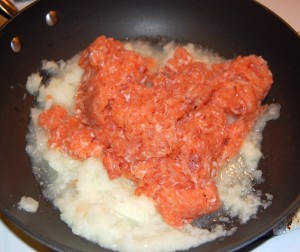
Other ingredients include fresh parsley leaves, minced celery, grated carrot, eggs, minced dulse leaf, herbs (basil, rosemary, thyme, oregano, lemon pepper), lemon zest, some starch, and some broth.
We made two substitutions: for the starch we used tapioca starch, while the recipe calls for shan yao, arrowroot starch, or powdered rolled oats; and we used lemon juice in place of the broth, where the recipe calls for chicken broth or filtered water.
Here are the ingredients mixed in our wok:
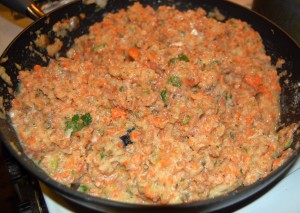
The next step was to divide into portions, form into balls, and press into patties. The patties are then covered and refrigerated overnight, or at least for several hours.
The recipe calls for lining a 13x9x2 baking pan with unbleached parchment or using muffin tins, and arranging the patties on a lightly oiled surface. We used aluminum foil on a cookie sheet and greased it with butter:
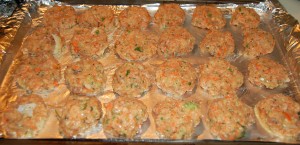
We cooked for 15 minutes at 350ºF until the patties were opaque throughout. Here’s how they came out:
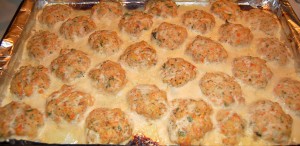
It appears our mix was a little too watery and bled a bit. Maybe the tapioca starch isn’t right for this recipe; or maybe we didn’t use enough seaweed. One of the variations was to replace the dulse with sea salt; we had a shortage of dulse and forgot to put in the sea salt, so perhaps that was the cause.
No matter; it tasted great. Here it is on a serving plate:
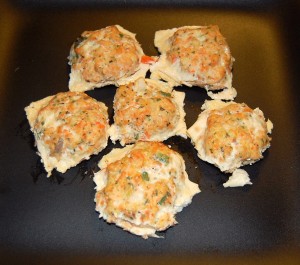
The recipe suggests dipping the cakes in one of the cookbook’s many sauces: Cajun Ketchup, Better Barbecue Sauce, herb infused Mayonnaise, or Tahini Tartar Sauce.
We found the cakes to be addictive: the more you ate the more you wanted another.
There’s a lot to be said for this recipe, apart from its healthy ingredients. The marinade takes away most of the fishy flavor, and the herbs cover the rest, so this may be palatable even to those who dislike salmon. Also, the cakes are a very portable form of salmon, easy to pack for lunch at work; they can be eaten as finger food.
Conclusion
We give two thumbs up to the recipe and the cookbook. Here’s a link to its Amazon page:








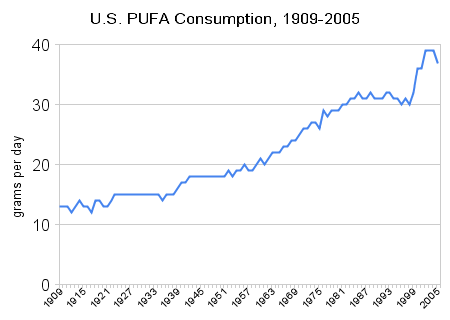

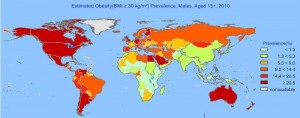






Recent Comments